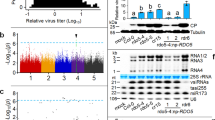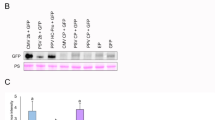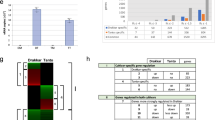Abstract
Some plant and animal pathogens can manipulate their hosts to cause them to release odors that are attractive to the pathogens' arthropod vectors. However, the molecular mechanism underlying this process is largely unexplored, and the specific effectors the pathogens employ as well as the pathways within the hosts they target are currently unknown. Here we reveal that the aphid-borne cucumber mosaic virus (CMV) employs its 2b protein, a well-characterized viral suppressor of host RNA interference (VSR), to target the host's jasmonate (JA) hormone pathway, thus acting as a viral inducer of host attractiveness to insect vectors (VIA). 2b inhibits JA signaling by directly interacting with and repressing JA-induced degradation of host jasmonate ZIM-domain proteins, instead of using its VSR activity. Our findings identify a previously defined VSR protein as a VIA and uncover a molecular mechanism CMV uses to manipulate host's attractiveness to insect vectors by targeting host hormone signaling.
Similar content being viewed by others
Log in or create a free account to read this content
Gain free access to this article, as well as selected content from this journal and more on nature.com
or
References
Liang G, Gao X, Gould EA . Factors responsible for the emergence of arboviruses; strategies, challenges and limitations for their control. Emerg Microbes Infect 2015; 4:e18.
Caplan J, Padmanabhan M, Dinesh-Kumar SP . Plant NB-LRR immune receptors: from recognition to transcriptional reprogramming. Cell Host Microbe 2008; 3:126–135.
Ng JC, Falk BW . Virus-vector interactions mediating nonpersistent and semipersistent transmission of plant viruses. Annu Rev Phytopathol 2006; 44:183–212.
McLeod G, Gries R, von Reuss SH, et al. The pathogen causing Dutch elm disease makes host trees attract insect vectors. Proc Biol Sci 2005; 272:2499–2503.
Lacroix R, Mukabana WR, Gouagna LC, Koella JC . Malaria infection increases attractiveness of humans to mosquitoes. PLoS Biol 2005; 3:e298.
O'Shea B, Rebollar-Tellez E, Ward RD, et al. Enhanced sandfly attraction to Leishmania-infected hosts. Trans R Soc Trop Med Hyg 2002; 96:117–118.
De Moraes CM, Stanczyk NM, Betz HS, et al. Malaria-induced changes in host odors enhance mosquito attraction. Proc Natl Acad Sci USA 2014; 111:11079–11084.
Mann RS, Ali JG, Hermann SL, et al. Induced release of a plant-defense volatile 'deceptively' attracts insect vectors to plants infected with a bacterial pathogen. PLoS Pathog 2012; 8:e1002610.
Mauck KE, De Moraes CM, Mescher MC . Deceptive chemical signals induced by a plant virus attract insect vectors to inferior hosts. Proc Natl Acad Sci USA 2010; 107:3600–3605.
Eigenbrode SD, Ding HJ, Shiel P, Berger PH . Volatiles from potato plants infected with potato leafroll virus attract and arrest the virus vector, Myzus persicae (Homoptera : Aphididae). Proc Biol Sci 2002; 269:455–460.
Palukaitis P, Garcia-Arenal F . Cucumoviruses. Adv Virus Res 2003; 62:241–323.
Ding SW . RNA-based antiviral immunity. Nat Rev Immunol 2010; 10:632–644.
Gonzalez I, Rakitina D, Semashko M, et al. RNA binding is more critical to the suppression of silencing function of cucumber mosaic virus 2b protein than nuclear localization. RNA 2012; 18:771–782.
Duan CG, Fang YY, Zhou BJ, et al. Suppression of Arabidopsis ARGONAUTE1-mediated slicing, transgene-induced RNA silencing, and DNA methylation by distinct domains of the cucumber mosaic virus 2b protein. Plant Cell 2012; 24:259–274.
Diaz-Pendon JA, Li F, Li WX, Ding SW . Suppression of antiviral silencing by cucumber mosaic virus 2b protein in Arabidopsis is associated with drastically reduced accumulation of three classes of viral small interfering RNAs. Plant Cell 2007; 19:2053–2063.
Zhang XR, Yuan YR, Pei Y, et al. Cucumber mosaic virus-encoded 2b suppressor inhibits Arabidopsis Argonaute1 cleavage activity to counter plant defense. Genes Dev 2006; 20:3255–3268.
Yan C, Xie D . Jasmonate in plant defence: sentinel or double agent? Plant Biotechnol J 2015; 13:1233–1240.
Wasternack C, Hause B . Jasmonates: biosynthesis, perception, signal transduction and action in plant stress response, growth and development. An update to the 2007 review in Annals of Botany. Ann Bot 2013; 111:1021–1058.
Browse J . Jasmonate passes muster: a receptor and targets for the defense hormone. Annu Rev Plant Biol 2009; 60:183–205.
Sheard LB, Tan X, Mao H, et al. Jasmonate perception by inositol-phosphate-potentiated COI1-JAZ co-receptor. Nature 2010; 468:400–407.
Yan JB, Zhang C, Gu M, et al. The Arabidopsis CORONATINE INSENSITIVE1 protein is a jasmonate receptor. Plant Cell 2009; 21:2220–2236.
Katsir L, Schilmiller AL, Staswick PE, He SY, Howe GA . COI1 is a critical component of a receptor for jasmonate and the bacterial virulence factor coronatine. Proc Natl Acad Sci USA 2008; 105:7100–7105.
Yan Y, Stolz S, Chételat A, et al. A downstream mediator in the growth repression limb of the jasmonate pathway. Plant Cell 2007; 19:2470–2483.
Thines B, Katsir L, Melotto M, et al. JAZ repressor proteins are targets of the SCFCOI1 complex during jasmonate signalling. Nature 2007; 448:661–665.
Chini A, Fonseca S, Fernández G, et al. The JAZ family of repressors is the missing link in jasmonate signalling. Nature 2007; 448:666–671.
Xie DX, Feys BF, James S, Nieto-Rostro M, Turner JG . COI1: an Arabidopsis gene required for jasmonate-regulated defense and fertility. Science 1998; 280:1091–1094.
Zhang F, Yao J, Ke J, et al. Structural basis of JAZ repression of MYC transcription factors in jasmonate signalling. Nature 2015; 525:269–273.
Song S, Qi T, Wasternack C, Xie D . Jasmonate signaling and crosstalk with gibberellin and ethylene. Curr Opin Plant Biol 2014; 21:112–119.
Pauwels L, Barbero GF, Geerinck J, et al. NINJA connects the co-repressor TOPLESS to jasmonate signalling. Nature 2010; 464:788–791.
Hong GJ, Xue XY, Mao YB, Wang LJ, Chen XY . Arabidopsis MYC2 interacts with DELLA proteins in regulating sesquiterpene synthase gene expression. Plant Cell 2012; 24:2635–2648.
Howe GA, Jander G . Plant immunity to insect herbivores. Annu Rev Plant Biol 2008; 59:41–66.
Liechti R, Farmer EE . The jasmonate pathway. Science 2002; 296:1649–1650.
Li R, Weldegergis BT, Li J, et al. Virulence factors of geminivirus interact with MYC2 to subvert plant resistance and promote vector performance. Plant Cell 2014; 26:4991–5008.
Bruce TJA, Matthes MC, Chamberlain K, et al. cis-Jasmone induces Arabidopsis genes that affect the chemical ecology of multitrophic interactions with aphids and their parasitoids. Proc Natl Acad Sci USA 2008; 105:4553–4558.
Ryabov EV, Fraser G, Mayo MA, Barker H, Taliansky M . Umbravirus gene expression helps potato leafroll virus to invade mesophyll tissues and to be transmitted mechanically between plants. Virology 2001; 286:363–372.
Wang XB, Jovel J, Udomporn P, et al. The 21-nucleotide, but not 22-nucleotide, viral secondary small interfering RNAs direct potent antiviral defense by two cooperative argonautes in Arabidopsis thaliana. Plant Cell 2011; 23:1625–1638.
Wang XB, Wu Q, Ito T, et al. RNAi-mediated viral immunity requires amplification of virus-derived siRNAs in Arabidopsis thaliana. Proc Natl Acad Sci USA 2010; 107:484–489.
Westwood JH, McCann L, Naish M, et al. A viral RNA silencing suppressor interferes with abscisic acid-mediated signalling and induces drought tolerance in Arabidopsis thaliana. Mol Plant Pathol 2013; 14:158–170.
Ji LH, Ding SW . The suppressor of transgene RNA silencing encoded by cucumber mosaic virus interferes with salicylic acid-mediated virus resistance. Mol Plant Microbe Interact 2001; 14:715–724.
Lewsey MG, Murphy AM, MacLean D, et al. Disruption of two defensive signaling pathways by a viral RNA silencing suppressor. Mol Plant Microbe Interact 2010; 23:835–845.
Ding SW, Li WX, Symons RH . A novel naturally occurring hybrid gene encoded by a plant RNA virus facilitates long distance virus movement. EMBO J 1995; 14:5762–5772.
Melotto M, Mecey C, Niu Y, et al. A critical role of two positively charged amino acids in the Jas motif of Arabidopsis JAZ proteins in mediating coronatine- and jasmonoyl isoleucine-dependent interactions with the COI1 F-box protein. Plant J 2008; 55:979–988.
Westwood JH, Lewsey MG, Murphy AM, et al. Interference with jasmonic acid-regulated gene expression is a general property of viral suppressors of RNA silencing but only partly explains virus-induced changes in plant-aphid interactions. J Gen Virol 2014; 95:733–739.
Dong K, Wang Y, Zhang Z, et al. Two amino acids near the N-terminus of cucumber mosaic virus 2b play critical roles in the suppression of RNA silencing and viral infectivity. Mol Plant Pathol 2016; 17:173–183.
Mauck K, Bosque-Perez NA, Eigenbrode SD, De Moraes CM, Mescher MC . Transmission mechanisms shape pathogen effects on host-vector interactions: evidence from plant viruses. Funct Ecol 2012; 26:1162–1175.
Lefevre T, Thomas F . Behind the scene, something else is pulling the strings: emphasizing parasitic manipulation in vector-borne diseases. Infect Genet Evol 2008; 8:504–519.
Gimenez-Ibanez S, Boter M, Fernandez-Barbero G, et al. The bacterial effector HopX1 targets JAZ transcriptional repressors to activate jasmonate signaling and promote infection in Arabidopsis. PLoS Biol 2014; 12:e1001792.
Jiang S, Yao J, Ma KW, et al. Bacterial effector activates jasmonate signaling by directly targeting JAZ transcriptional repressors. PLoS Pathog 2013; 9:e1003715.
Ziebell H, Murphy AM, Groen SC, et al. Cucumber mosaic virus and its 2b RNA silencing suppressor modify plant-aphid interactions in tobacco. Sci Rep 2011; 1:187.
Hogenhout SA, Ammar el D, Whitfield AE, Redinbaugh MG . Insect vector interactions with persistently transmitted viruses. Annu Rev Phytopathol 2008; 46:327–359.
Ng JC, Falk BW . Virus-vector interactions mediating nonpersistent and semipersistent transmission of plant viruses. Annu Rev Phytopathol 2006; 44:183–212.
Acknowledgements
We thank Rongxiang Fang and Huishan Guo for the gifts of SD-CMV and plasmids. This work was supported by the National Natural Science Foundation of China (31421001, 31630085 and 31500228), the Ministry of Science and Technology of China (2016YFA0500501) and an endowment from College of natural and Agricultural Sciences, University of California, Riverside, USA.
Author information
Authors and Affiliations
Corresponding authors
Additional information
( Supplementary information is linked to the online version of the paper on the Cell Research website.)
Supplementary information
Supplementary information, Figure S1
Experimental setup for circular-dish and Y-tube aphid attraction bioassays. (PDF 129 kb)
Supplementary information, Figure S2
The expression level of the 2b protein in transgenic plants. (PDF 28 kb)
Supplementary information, Figure S3
2b interacts with Arabidopsis JAZ1. (PDF 26 kb)
Supplementary information, Figure S4
Negative controls for BiFC assay. (PDF 105 kb)
Supplementary information, Figure S5
Phylogenetic analysis of various CMV strains. (PDF 209 kb)
Supplementary information, Figure S6
Phylogenetic analysis of Arabidopsis and tobacco JAZ proteins. (PDF 95 kb)
Supplementary information, Figure S7
The JAZ-2b and JAZ-COI1 interactions are incompatible. (PDF 140 kb)
Supplementary information, Figure S8
Quantitative analysis of in vitro degradation of JAZ1. (PDF 351 kb)
Supplementary information, Figure S9
2b inhibits in vitro degradation of JAZ1. (PDF 40 kb)
Supplementary information, Figure S10
2b suppresses JA-inducible gene expression. (PDF 363 kb)
Rights and permissions
About this article
Cite this article
Wu, D., Qi, T., Li, WX. et al. Viral effector protein manipulates host hormone signaling to attract insect vectors. Cell Res 27, 402–415 (2017). https://doi.org/10.1038/cr.2017.2
Received:
Revised:
Accepted:
Published:
Issue date:
DOI: https://doi.org/10.1038/cr.2017.2
Keywords
This article is cited by
-
The pathogen effector BcSSP2 suppresses the NPC phase separation to facilitate Botrytis cinerea infection
Nature Communications (2025)
-
Perception of viral infections and initiation of antiviral defence in rice
Nature (2025)
-
Arbovirus suppression of a lectin protein-mediated broad-spectrum resistance enhances herbivorous vector performance and viral transmission
Nature Communications (2025)
-
Unraveling insect feeding patterns and their ecological impacts on plant defense mechanisms
Journal of Plant Diseases and Protection (2025)
-
Leafhopper salivary vitellogenin mediates virus transmission to plant phloem
Nature Communications (2024)



